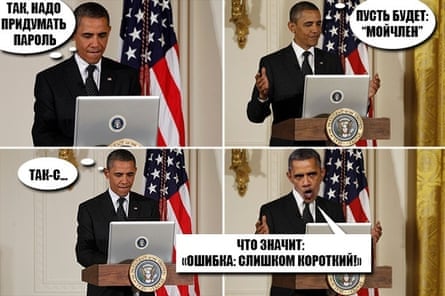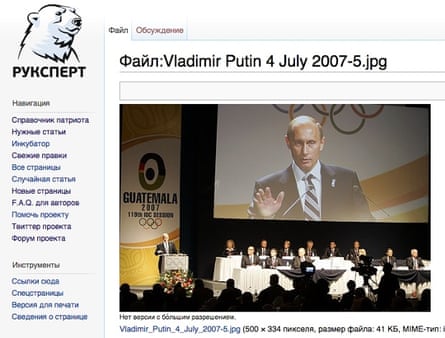Just after 9pm each day, a long line of workers files out of 55 Savushkina Street, a modern four-storey office complex with a small sign outside that reads “Business centre”. Having spent 12 hours in the building, the workers are replaced by another large group, who will work through the night.
The nondescript building has been identified as the headquarters of Russia’s “troll army”, where hundreds of paid bloggers work round the clock to flood Russian internet forums, social networks and the comments sections of western publications with remarks praising the president, Vladimir Putin, and raging at the depravity and injustice of the west.
The Guardian spoke to two former employees of the troll enterprise, one of whom was in a department running fake blogs on the social network LiveJournal, and one who was part of a team that spammed municipal chat forums around Russia with pro-Kremlin posts. Both said they were employed unofficially and paid cash-in-hand.
They painted a picture of a work environment that was humourless and draconian, with fines for being a few minutes late or not reaching the required number of posts each day. Trolls worked in rooms of about 20 people, each controlled by three editors, who would check posts and impose fines if they found the words had been cut and pasted, or were ideologically deviant.
The LiveJournal blogger, who spent two months working at the centre until mid-March, said she was paid 45,000 roubles (£520, $790) a month, to run a number of accounts on the site. There was no contract - the only document she signed was a non-disclosure form. She was ordered not to tell her friends about the job, nor to add any of them to the social media accounts she would run under pseudonyms.
“We had to write ‘ordinary posts’, about making cakes or music tracks we liked, but then every now and then throw in a political post about how the Kiev government is fascist, or that sort of thing,” she said.
Scrolling through one of the LiveJournal accounts she ran, the pattern is clear. There are posts about “Europe’s 20 most beautiful castles” and “signs that show you are dating the wrong girl”, interspersed with political posts about Ukraine or suggesting that the Russian opposition leader Alexei Navalny is corrupt.

Instructions for the political posts would come in “technical tasks” that the trolls received each morning, while the non-political posts had to be thought up personally.
“The scariest thing is when you talk to your friends and they are repeating the same things you saw in the technical tasks, and you realise that all this is having an effect,” the former worker said.
Marat, 40, worked in a different department, where employees went methodically through chat forums in various cities, leaving posts.
“First thing in the morning, we’d come in, turn on a proxy server to hide our real location, and then read the technical tasks we had been sent,” he said.
The trolls worked in teams of three. The first one would leave a complaint about some problem or other, or simply post a link, then the other two would wade in, using links to articles on Kremlin-friendly websites and “comedy” photographs lampooning western or Ukrainian leaders with abusive captions.
Marat shared six of his technical task sheets from his time in the office with the Guardian. Each of them has a news line, some information about it, and a “conclusion” that the commenters should reach. One is on Putin offering his condolences to President François Hollande after the Charlie Hebdo shootings in Paris.
“Vladimir Putin contacted the French leader immediately, despite the bad relations between Russia and the west,” reads the section explaining the conclusion the troll posts should reach. “The Russian leader has always stood against aggression and terrorism in general. Thanks to the president’s initiatives, the number of terrorist acts inside Russia has decreased dramatically.”
The other task sheets demand glowing reviews of the YotaPhone, a Russian-made smartphone, abuse and teasing for Jennifer Psaki, the former US state department spokeswoman, and three relate to Ukraine and the west’s plans there.
The desired conclusion of one reads: “The majority of experts agree that the US is deliberately trying to weaken Russia, and Ukraine is being used only as a way to achieve this goal. If the Ukrainian people had not panicked and backed a coup, the west would have found another way to pressure Russia. But our country is not going to go ahead with the US plans, and we will fight for our sovereignty on the international stage.”
To add colour to their posts, websites have been set up to aid the troll army. One features thousands of pasteable images, mainly of European leaders in humiliating photoshopped incidents or with captions pointing out their weakness and stupidity, or showing Putin making hilarious wisecracks and winning the day.
Many of them have obvious racist or homophobic overtones. Barack Obama eating a banana or depicted as a monkey, or the Ukrainian president, Petro Poroshenko, in drag, declaring: “We are preparing for European integration.” The trolls have to post the photographs together with information they can pull from a website marketed as a “patriotic Russian Wikipedia”, featuring ideologically acceptable versions of world events.
The entries for the Maidan revolution in Kiev explain that all the protesters were fed special tea laced with drugs, which is what caused the revolution.

The trolls were firmly instructed that there should never be anything bad written about the self-proclaimed Donetsk People’s Republic (DNR) or the Luhansk People’s Republic (LNR), and never anything good about the Ukrainian government.
“I would go home at the end of the day and see all the same news items on the television news. It was obvious that the decisions were coming from somewhere,” said Marat. Many people have accused Russian television of ramping up propaganda over the past 18 months in its coverage of Ukraine, so much so that the EU even put Dmitry Kiselev, an opinionated television host and director of a major news agency, on its sanctions list.
After two months of working in the troll agency, Marat began to feel he was losing his sanity, and decided he had to leave. From the snatched conversations over coffee, he noted that the office was split roughly 50/50 between people who genuinely believed in what they were doing, and those who thought it was stupid but wanted the money. Occasionally, he would notice people changing on the job.
“Of course, if every day you are feeding on hate, it eats away at your soul. You start really believing in it. You have to be strong to stay clean when you spend your whole day submerged in dirt,” he said.
The most prestigious job in the agency is to be an English-language troll, for which the pay is 65,000 roubles. Last year, the Guardian’s readers’ editor said he believed there was an “orchestrated pro-Kremlin campaign” on the newspaper’s comment boards.
As he spoke decent English, Marat was sent for a test in the English language department, where he was given the task of writing a one-page text in English about his political views. Not wanting to overdo it, he wrote that he was apolitical, and thought all politics were cynical. It was not good enough to pass.
Before he was told he had failed, however, other people in the room were told they had passed the preliminary test and were set to work composing comments on two English-language articles about Ukraine – one by the New York Times and another by CNN.
Lawyers in St Petersburg said it was extremely rare for such a big enterprise to be working entirely on the “black economy”, not paying any tax and not officially registering its employees. Leaked documents have linked the opaque company running the troll factory to structures close to the Kremlin, but there has been no hard evidence. As long ago as 2012 there were leaks suggesting Kremlin youth groups were funding online troll activities.
It is unclear whether the St Petersburg troll hub is the only one or whether there are many others, but what does seem clear is that the enterprise has grown enormously since it was discovered two years ago.
“When I got the job there in 2013 it was a small building, I was working in the basement, and it was clear they didn’t have enough space,” said Andrei Soshnikov, a St Petersburg journalist who infiltrated the company two years ago and has continued to cover it. He linked the move to a much bigger office with increased online activity around the Ukraine crisis, and said that while the trolling can seem farcical, it would be naive to write it off as ineffectual, especially in the domestic arena.
“People of my generation who grew up with the internet can perhaps spot the troll comments easily. But for the older generation, people who are used to television and are just getting online, they look at all these forums and networks, and it turns out that everyone else out there is even more radical than they are, than their neighbours are.”

Comments (…)
Sign in or create your Guardian account to join the discussion